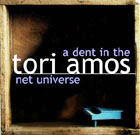
|
Technical Tori Article In Pro Sound News |

|
Technical Tori Article In Pro Sound News |
This article was posted to the various Tori mailing lists by Richard Handal.
Publication: Pro Sound News (European edition) (ISSN: 0269-4735)
Date: October, 1995 Page: 3 Article Type: Interview Writer: Phil Ward
Photos: One color photo 3.7" W x 2.4" H of the recording setup described
in the article, with the piano and harpsichord separated by the V-shaped
baffle arrangement; with pews in the foreground, and church
architectural ornamentation including stained glass windows with
sunlight shining through them, in the background
Caption: Unique acoustic screening separated the two keyboards and the
singer
Headline: Hallmark of quality for Tori album
IRELAND -- Tori Amos has been recording her third album at home in Cork and on location in a church in Delgany, exploiting the natural acoustics of the aged building with Neumann microphones and a unique approach to the problem of isolation.
Engineer Mark Hawley, who has been responsible for the American singer's FOH house for nearly two years, fashioned an acoustic screen between her favoured piano and harpsichord to create sufficient separation while the overdub-free keyboard and vocal performance was executed. Some songs featured both keyboards--"I wanted the overhang from the piano when I hit the harpsichord," Amos reveals.
"In order to separate the vocal signal from the piano and harpsichord mics," says Hawley, "we built a wooden construction, acoustically tiled on the inside, which encased the two keyboards. The instruments could then be mic'd in the hall while she sang in an entirely separate acoustic space."
Nick-named `Tori's house', the device enabled an intimate recording via four U87s, two KM184s and four KM140/130 modular stereo kits straight to Sony digital multitrack by way of Focusrite pre-amps. A 60-year old M49, acquired by Tori Amos from a Canadian radio station, was also used on vocals.
"Her vocal sound is exact and we were able to capture it without compromising the keyboards," adds Hawley, "which were recorded with full ambience in the church. On the piano we had just two U87s as a stereo cardioid pair, while two KM184s were configured as closely as possible to an ORTF pair.
"Then we used an A-B pair of KM130s about two feet away from the piano, which was recorded with the lid off to provide a more ambient signal. We were recording in the main church hall, with a beautiful acoustic and a very gentle reverb, so we added a couple of KM130s at the back of the hall just to pick up the reverb trail. The results are amazing." Phil Ward
<>====<>====<>====<>====<>====<>====<>====<>====<>====<>====<>
Notes from Richard: FOH means "front of house." Overhang here refers to the sound of the piano as it slowly fades out, while the harpsichord comes in. ORTF is a mic positioning where the capsules are placed 17 cm (approx. 7") apart at a 110 degree angle. "A-B" is another pattern of microphone positioning. Cardioid is a loose, unidirectional pattern describing the "live" areas from which a mic picks up its sound.
I came across the following ad for the model of microphone Tori used for her vocals: "Beautiful M-49 tube mic complete with box, hanger, new cable and power supply- Has brand new old stock KK-49 capsule. $5300.00 plus shipping- Firm"
Anyone interested in the microphones described in this article should check out the Neumann website at http://www.neumann.com. The Neumann company (pronounced NOY-man) has a rich history, and has contributed mightily through the modern era of recorded sound.
Please give me feedback, comments, or suggestions about my site. Email me (Michael Whitehead) at mikewhy@iglou.com
